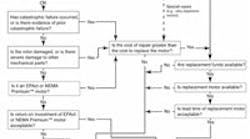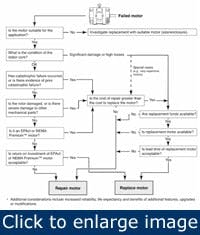When production drops in a weak economy, plant managers often try to control costs by delaying replacement or repair of failed electric motors. While this might save money in the short term, it could put the plant at a competitive disadvantage when the economy revives itself. A better approach to motor management during slack periods is to target mission-critical equipment with a sound motor repair/replacement policy.
[pullquote]It’s easy to find so-called expert opinions in the trade press or on the Internet that explain which motors to repair or replace. So, it shouldn’t be too hard to draft a good repair/replace policy, right? Unfortunately, much of this free advice ignores motor type and size, as well as differences in applications, hours of operation and load conditions that detail how, where and when the motor is used.
Often such advice fails to consider modifications that might be needed or the time it might take to procure a new motor. Worse still, some of these expert opinions recommend replacing every motor that fails, based on the questionable assumption that repair inherently degrades motor efficiency, or that energy-efficient and premium-efficient motors are impossible to repair or rewind.
Energy-efficient motors — the facts
A good motor repair/replace policy is based on scientific facts, not opinions or assumptions. For starters, nothing about energy-efficient or premium-efficient motors is magical or mysterious. Manufacturers simply improved the efficiency of these models by minimizing the amount of input electrical energy that’s lost to heat, friction and windage. Simply put, there are no technological breakthroughs associated with these motors.
To reduce core losses, for example, some energy-efficient models have stator and rotor cores that are longer than those on standard motors. More copper in the windings decreases copper losses, and open or shielded bearings (lubricated with a premeasured quantity of grease) reduce friction. To minimize the input power needed for cooling, the totally enclosed, fan-cooled (TEFC) designs use the smallest fan that can handle the job.
Effect of repair and rewinding — the facts
A 2003 rewind study commissioned by the Electrical Apparatus Service Association (EASA, U.S.A.) and the Association of Electrical and Mechanical Trades (AEMT, U.K.) proved scientifically that following the best practices detailed in the study maintains the energy efficiency of high-efficiency NEMA and IEC motors. The motors covered by the study ranged from the EPAct level (original U.S. federal law enacted in 1992) to the NEMA Premium and IEC EFF1 levels.
The study, performed at the University of Nottingham (U.K.), tested 22 motors ranging in size from 50 hp to 200 hp (37 kW to 150 kW), before and after multiple winding burnouts and rewinds. A 1998 study by AEMT also proved that the efficiency of lower-horsepower motors can be maintained during repair, dispelling the notion that, of themselves, winding burnout and removal will damage the core beyond repair.
According to these studies, following best practices during repair is critical to maintaining motor efficiency. Controlling bearing friction loss, for example, requires using the original bearing type, maintaining or restoring the proper bearing journal and housing fits, using the correct quantity of lubricant and “running in” the bearings before testing the motor efficiency. Copies of the most recent study are available from the “Industry Info” button at www.easa.com.
To retain the original efficiency of repaired or rewound motors, use a service center that follows ANSI/EASA AR100-2006, “Recommended Practice for the Repair of Rotating Electrical Apparatus,” and the Rewind Study’s “Good Practice Guide.”
Crafting a repair/replace policy
Figure 1. This flowchart lists the major decision points for specifying either a rewind or a complete motor replacement.
A motor repair/replace policy is useful for determining the best course of action when a motor fails. But, each application is unique. Although the extensive flowchart in Figure 1 lists key decision points, it doesn’t cover every possibility.
Application review: The first step is to determine if the failed motor is suitable for the application. A motor with an open enclosure, for instance, might not be practical for a sawmill application and its airborne dust and debris. A better choice might be a TEFC replacement. Processes and duty cycles often change over time, so it always pays to reexamine the application when deciding whether to repair or replace a failed motor.
If the failed motor was a good fit for the application, evaluate the condition of the stator core. Has it sustained significant damage? Did the motor exceed its rated temperature rise (i.e., high core losses)? Absent special features that might affect price or availability, it might cost less to buy a new motor than to repair a badly damaged stator core. Next, consider these decision points simultaneously:
- Has catastrophic failure occurred?
- Is there evidence of a past catastrophic failure?
- Is the rotor damaged?
- Are other mechanical parts severely damaged?
- Is it an EPAct, NEMA Premium or IEC EFF1 motor?
If a catastrophic failure occurred, weigh the cost of repairing the motor against that of replacing it. Such failures typically cause significant damage to the stator core and windings, as well as to the rotor, shaft, bearings and end brackets. In such cases, replacement might be the most economical option – especially if you question the suitability of the motor for the application.
Rotor damage varies widely, from surface smearing caused by contact with the stator, to melted bars and end rings on die-cast designs, to lifted bars or broken end rings on fabricated designs. Surface smearing often can be repaired economically. Other kinds of rotor repair might not be feasible unless the motor is very large or has special features.
The shaft, frame and other mechanical parts also might be damaged so badly that they must be replaced. Here again, the cost of buying or making a new shaft, or of purchasing a new frame, might make repair a less attractive choice than replacing the motor unless the motor is very large or has special features.
Earlier catastrophic failure sometimes is evident after disassembly. Examples include a bent shaft that has bent again, a damaged rotor core or damaged rotor bars or end rings, and damaged stator core laminations. Whether you choose to repair or replace the motor, be sure to identify the contributing causes of failure to prevent a recurrence.
Motor efficiency plays a role: The points discussed so far have shaped motor repair-replace decisions for more than 50 years. The advent of energy-efficient motors introduced another consideration: whether to replace the failed motor with a more energy-efficient model.
“The Effect of Repair/Rewinding on Motor Efficiency: EASA/AEMT Rewind Study and Good Practice Guide to Maintain Motor Efficiency.” Electrical Apparatus Service Association, Inc. and Association of Electrical and Mechanical Trades. St. Louis, Mo., USA and York, England UK, 2003. (Available for download on the “Industry Info” page at www.easa.com.)
“ANSI/EASA AR100-2006: Recommended Practice for the Repair of Rotating Electrical Apparatus.” Electrical Apparatus Service Association, Inc. St. Louis, MO USA, 2006. (Available for download on the “Industry Info” page at www.easa.com.)
Broadly speaking, energy-efficient motors are covered by U.S. federal regulations (EPAct), IEC motors labeled EFF1, as well as newer, premium-efficient models (e.g., NEMA Premium). Repair considerations for these motors are the same as for standard-efficiency models. Following the good practices of the EASA/AEMT rewind study, qualified service centers can repair any of these motors without affecting the efficiency rating.
Before repairing a standard-efficiency motor, consider the return on investment for a more energy-efficient replacement. Take into account the expected life of the motor or process, load conditions, hours of operation, the price of electricity and any modification costs.
If your analysis shows that replacement is preferable to repair, the next consideration is whether you have the money in your budget. If not, you might still opt for repair as long as it costs less than a new motor.
Assuming you have the funds for a new motor, the next decision point is availability. Motors that fall under EPAct rules normally are stock items. Delivery times for larger motors, or for those with special features, often range from a few weeks to several months. If the delivery time is longer than you can tolerate, a qualified service center usually can repair the original motor in far less time. It also might be able to add the special features you need to a stock motor, e.g., by converting it to a C-face mounting.
Addressing critical motor repair and replacement concerns during economic slowdowns enables you to ramp up production quickly as market conditions improve. Implementing a sound motor repair/replacement policy today also will ensure wise management of plant assets well into the future.
Thomas H. Bishop, P.E., is a technical support specialist at the Electrical Apparatus Service Association (EASA), St. Louis. Contact him at (314) 993-2220.

